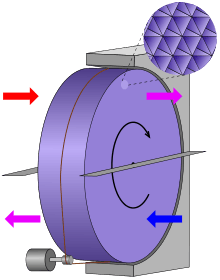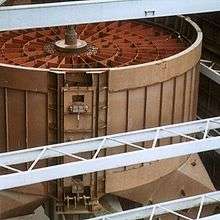Thermal wheel


A thermal wheel, also known as a rotary heat exchanger, or rotary air-to-air enthalpy wheel, or heat recovery wheel, is a type of energy recovery heat exchanger positioned within the supply and exhaust air streams of an air-handling system or in the exhaust gases of an industrial process, in order to recover the heat energy. Other variants include enthalpy wheels and desiccant wheels. A cooling-specific thermal wheel is sometimes referred to as a Kyoto wheel.
Description
A thermal wheel consists of a circular honeycomb matrix of heat-absorbing material, which is slowly rotated within the supply and exhaust air streams of an air-handling system. As the thermal wheel rotates, heat is picked up from the exhaust air stream in one half of the rotation and given up to the fresh air stream in the other half of the rotation. Thus waste heat energy from the exhaust air stream is transferred to the matrix material and then from the matrix material to the fresh air stream, raising the temperature of the supply air stream by an amount proportional to the temperature differential between air streams, or "thermal gradient", and depending upon the efficiency of the device. Heat exchange is most efficient when the streams flow in opposite directions, since this causes a favourable temperature gradient across the thickness of the wheel. The principle of course works in reverse, and "cooling" energy can be recovered to the supply air stream if so desired and the temperature differential allows.
The heat exchange matrix may be aluminium, plastic, or synthetic fiber. The heat exchanger is rotated by a small electric motor and belt drive system. The motors are often inverter speed-controlled for improved control of the leaving air temperature. If no heat exchange is required, then the motor can be stopped altogether.
Because of the nature of thermal wheels in the way that heat is transferred from the exhaust air stream to the supply air stream without having to pass directly through an exchange medium, the gross efficiencies are usually much higher than that of any other air-side heat recovery system. The shallower depth of the heat exchange matrix, as compared to that, say, for a plate heat exchanger, means that the pressure drop through the device is normally lower in comparison. Generally, a thermal wheel will be selected for face velocities between 1.5 and 3.0 metres per second (4.9 and 9.8 ft/s), and with equal air volume flow rates, gross "sensible" efficiencies of 85% can be expected. Although there is a small extra energy requirement to rotate the wheel, the motor energy consumption is usually very low and has little effect upon the seasonal efficiency of the device. In addition, the ability to recover "latent" heat, depending upon the materials and coatings used, can improve gross efficiencies by 10–15%.
Energy transfer process
Normally the heat transfer between airstreams provided by the device is termed as "sensible", which is the exchange of energy, or enthalpy, resulting in a change in temperature of the medium (air in this case), but with no change in moisture content. However, if moisture or relative humidity levels in the return air stream are high enough to allow condensation to take place in the device, then this will cause "latent" heat to be released, and the heat transfer material will be covered with a film of water. Despite a corresponding absorption of latent heat, as some of the water film is evaporated in the opposite airstream, the water will reduce the thermal resistance of the boundary layer of the heat exchanger material and thus improve the heat transfer coefficient of the device, and hence increase efficiency. The energy exchange of such devices now comprises both sensible and latent heat transfer; in addition to a change in temperature, there is also a change in moisture content of the air streams.
However, the film of condensation will also slightly increase pressure drop through the device, and depending upon the spacing of the matrix material, this can increase resistance by up to 30%. This will increase fan energy consumption and reduce the seasonal efficiency of the device.
Aluminium matrices are also available with an applied hygroscopic coating, and the use of this, or the use of porous synthetic fibre matrices, allows for the adsorption and release of water vapour, at moisture levels much lower than that normally required for condensation and latent heat transfer to occur. The benefit of this is an even higher heat transfer efficiency, but it also results in the drying or humidification of air streams, which may also be desired for the particular process being served by the supply air.
For this reason these devices are also commonly known as an enthalpy wheel.
Use in gas turbines
During the automotive industry's interest in gas turbines for vehicle propulsion (around 1965), Chrysler invented a unique type of rotary heat exchanger[1] that consisted of a rotary drum constructed from corrugated metal (similar in appearance to corrugated cardboard). This drum was continuously rotated by reduction gears driven by the turbine. The hot exhaust gasses were directed through a portion of the device, which would then rotate to a section that conducted the induction air, where this intake air was heated. This recovery of the heat of combustion significantly increased the efficiency of the turbine engine. This engine proved impractical for an automotive application due to its poor low-rpm torque. Even such an efficient engine, if large enough to deliver the proper performance, would have a low average fuel efficiency. Such an engine may at some future time be attractive when combined with an electric motor in a hybrid vehicle owing to its robust longevity and an ability to burn a wide variety of liquid fuels.
Desiccant wheel
A desiccant wheel is very similar to a thermal wheel, but with a coating applied for the sole purpose of dehumidifying, or "drying", the air stream. The desiccant is normally silica gel. As the wheel turns, the desiccant passes alternately through the incoming air, where the moisture is adsorbed, and through a “regenerating” zone, where the desiccant is dried and the moisture expelled. The wheel continues to rotate, and the adsorbent process is repeated. Regeneration is normally carried out by the use of a heating coil, such as a water or steam coil, or a direct-fired gas burner.
Thermal wheels and desiccant wheels are often used in series configuration to provide the required dehumidification as well as recovering the heat from the regeneration cycle.
Disadvantages
Thermal wheels are not suitable for use where total separation of supply and exhaust air streams is required, since air will bypass at the interface between the air streams at the heat exchanger boundary, and at the point where the wheel passes from one air stream to the other during its normal rotation. The former is reduced by brush seals, and the latter is reduced by a small purge section, formed by plating off a small segment of the wheel, normally in the exhaust air stream.
Matrices made from fibrous materials, or with hygroscopic coatings, for the transfer of latent heat, are far more susceptible to damage and degradation by "fouling" than plain metal or plastic materials, and are difficult or impossible to effectively clean if dirty. Care must be taken to properly filter the air streams on both exhaust and fresh air sides of the wheel.
Other types of air-to-air heat exchangers
- Run around coil
- Recuperator, or cross plate heat exchanger
- Heat pipe
See also
References
External links
- Enthalpy wheels at the Apogee energy library
- Study on using Enthalpy wheels at airports from San Jose State University
- Enthalpy wheel data from the Live Building at Queen's University